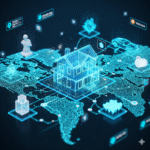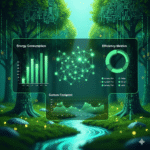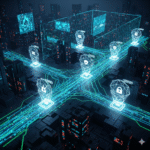When biology meets technology, a new realm of possibility is born—living intelligence. In 2025, this intersection is no longer a speculative domain of science fiction but an active area of research and innovation. The integration of biological systems with digital technologies is transforming medicine, computing, robotics, and beyond.
This convergence is not only reshaping industries but also prompting deeper questions about consciousness, cognition, and the future of human-machine interactions.
What is Living Intelligence?
Living intelligence refers to the synergy between biological systems (like neurons or entire organisms) and artificial technologies to create adaptive, learning, and decision-making entities. Unlike traditional artificial intelligence, which relies solely on code and algorithms, living intelligence may include biocomputers, neural interfaces, or even cyborg organisms—blurring the lines between life and machine.
Biological Computing: Cells as Circuits
Researchers are increasingly turning to biological substrates to process information. DNA computing and protein-based logic gates are examples where cells themselves can function as tiny computers. These bio-computers hold the potential to outperform silicon chips in certain problem-solving tasks—especially in energy efficiency and adaptability.
Brain-Computer Interfaces: Thought-Controlled Tech

One of the most promising applications of living intelligence is the brain-computer interface (BCI). BCIs enable direct communication between the human brain and external devices, allowing people to control prosthetic limbs, type text, or navigate systems using only their thoughts. This has profound implications for medicine, especially for individuals with mobility impairments or neurological disorders.
Soft Robotics and Biohybrids
Soft robotics, enhanced by biological tissues and synthetic materials, are another breakthrough area where biology meets technology. These robots mimic the flexibility and responsiveness of natural organisms, enabling more natural motion and greater adaptability in uncertain environments. Some systems even use living muscle cells to power movement, a true blend of the organic and artificial.
Synthetic Biology and Machine Learning
Synthetic biology uses machine learning to design and engineer genetic circuits, creating programmable cells that can sense and respond to their environment. This is driving innovation in agriculture, healthcare, and environmental science. For example, programmable bacteria can be deployed to detect toxins or deliver drugs directly inside the human body.
Neural Tissue Engineering and Bio-AI
Another frontier is the creation of bioengineered neural networks. Scientists are growing brain-like tissue in laboratories and linking it to AI systems to explore new forms of cognition. These organoid-intelligence models may one day lead to machines that don’t just simulate intelligence—but embody it through biological structure.
Ethical and Philosophical Challenges
As we dive deeper into living intelligence, ethical questions arise. What rights should a biohybrid or semi-living system have? Where do we draw the line between machine and organism? These are not hypothetical questions—they are becoming central to the development of policy and frameworks around bio-digital convergence.
The Road Ahead
When biology meets technology, we don’t just enhance machines—we redefine what it means to be intelligent, adaptable, and alive. From medical breakthroughs to reimagining cognition, living intelligence is unlocking capabilities that will transform our relationship with technology. In 2025, we stand at the threshold of a future where biology and technology no longer coexist—they collaborate.
Expanding Horizons: Future Applications of Living Intelligence
Looking beyond 2025, the fusion of biology and technology hints at even more transformative applications. Researchers are exploring bio-integrated wearable devices that monitor health in real time, providing early warnings for diseases like cancer or Alzheimer’s. These devices may eventually become seamless extensions of our bodies, operating with minimal external intervention.
In the realm of environmental science, living intelligence offers radical solutions for climate change. Engineered organisms could help sequester carbon dioxide, purify polluted water, or regenerate damaged ecosystems. Biohybrid drones equipped with living cells might one day monitor and repair environmental damage autonomously.
Education and learning processes are also poised for revolution. With brain-computer interfaces advancing, we may soon be able to upload skills directly into our neural pathways, accelerating the way we acquire knowledge. Personalized learning platforms powered by biological and AI convergence could adapt instantly to a learner’s cognitive state.
Conclusion
Living intelligence represents more than a technological leap—it signifies a paradigm shift in how we understand life itself. As the boundaries between the organic and the artificial continue to blur, humanity must navigate this new frontier thoughtfully, balancing innovation with responsibility.
In 2025 and beyond, when biology meets technology, the possibilities are not just extraordinary—they are alive.





